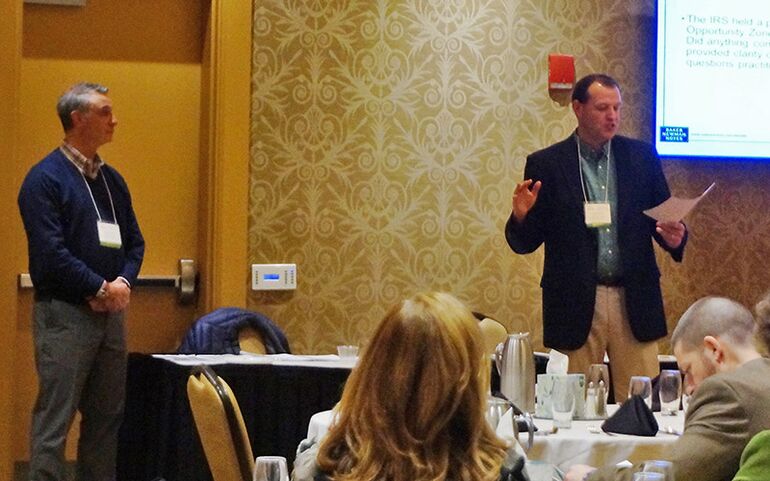Real estate industry still waiting for final Opportunity Zone rules
 Photo / Maureen Milliken
Nelson Toner, left, of Bernstein Shur, and Andrew Smith, of Baker Newman Noyes, discuss Opportunity Zones Tuesday morning at a MEREDA breakfast workshop
Photo / Maureen Milliken
Nelson Toner, left, of Bernstein Shur, and Andrew Smith, of Baker Newman Noyes, discuss Opportunity Zones Tuesday morning at a MEREDA breakfast workshop
BANGOR — More than a year after the Opportunity Zone tax benefit was written into federal tax law, and five months after proposed rules were issued, investors, real estate agents and developers are still waiting for final rules from the U.S. Treasury.
While they wait, Opportunity Zone projects are slow to get off the ground and many details of how it works are still not clear, those who attended a Maine Real Estate and Development Association breakfast workshop on the topic were told.
Before those rules are finalized, there could also be some significant changes, Nelson Toner of Bernstein Shur and Andrew Smith of Baker Newman Noyes told the group.
The Feb. 14 hearing was originally scheduled for January, but delayed because of the federal shutdown, further dragging out the process.
“Not only do [the rules] have to be written, but they have to be reviewed,” before they’re final, Toner said. “It may take another 30 to 60 days.”
“There are a few, not a lot” of Opportunity Zone projects going forward in the state as the rule-making progresses, he said.
The tax benefit allows partnerships and corporations organized specifically to invest in a qualified Opportunity Zone to defer capital gains taxes on the money invested in the fund, as well as profits made on the property. It’s designed to boost economic development in what is officially referred to as “distressed areas,” as well as create jobs.
Significant improvements must be made to either business property or a business itself in the zone to reap the tax benefit.
Capital gains invested in the fund may be temporarily deferred for up to nine years, with a 10% reduction in tax on the gain if the investor holds interest in the fund for five years. There is an additional 5% reduction in tax if the interest in the fund is held for seven years.
If it’s held for at least 10 years, gains realized on the investment of the original deferred gains are excluded from tax. Any gains made in connection with the original investment are still taxed at this point, but less 15%.
There are 32 zones in Maine, and 8,761 nationwide. The U.S. Treasury estimates $100 billion will be invested in Opportunity Zones.
Some hurdles to jump
One “major hurdle” that was discussed at the Treasury hearing in February is that is that 90% of the LLC or partnership assets must be invested into an Opportunity Zone fund within six months to reap the tax benefits, Toner said.
Smith agreed that where development is involved, saying: “Six months is way too short a time,”
Toner said that many stakeholders are advocating for a year, while some are pushing for 30 months.
“Hopefully we’ll see that at least extended to a year,” he said.
Another concern is whether land bought before Jan. 1, 2018, when the lax law went into effect can be developed in a zone and get the tax benefit. “That would have particular impact here in Maine,” Toner said.
There are other questions surrounding the makeup of partnerships and nuts and bold of the investing process.
Unclear business development language
Toner said most Opportunity Zone projects will likely be property development, but improvement of a business is also part of the law and language is still not clear regarding how that would work.
Language about businesses that are invested in, for example, says that “substantially all” of the business’s property must be in the Opportunity Zone — but that phrase and other language is not specific enough to help businesses determine if they’re a good fit.
He said when a business is brand new, “How do they know they’re going to qualify [within the time frame]?”
He said one possibility would be to change the rules so that if a business knew within the time frame that it would ultimately qualify in the future, it would not be penalized.
“How do you do due diligence? That’s one of the struggles,” he said.
The law also says that at least 50% of gross income of the business must be “derived from an active trade or business.”
“What does that mean?” Toner said.
He said there are concerns about having operating capital if the rules are that rigid..
“[A business] has to have cash available, has to be able to do things,” he said.
He said there’s uncertainty “about where these rules are going.”
Some things are clear
Some of the rules established in October, however, are clear and make the program accessible.
One big one is that it’s self-certifying — the LLC or partners need only to indicate that’s what they are on their tax return.
Also straightforward is the language about property improvement once the fund invests in the zone.
The statute requires that property in the zone, after being acquired by an Opportunity Zone fund, be either new or “substantially improved,” within 30 months.
“Substantially improved” means that investment on developing the property once it’s bought must equal what was spent on it “and a dollar more,” Smith said.
Smith used the example that a partnership invests $1 million in a zone, $400,000 into a a building and $600,000 into land. If $400,001 in improvements is spent on the building in 30 months, that is adequate.
Unlike other programs, no certificate of occupancy, or other measure of completion is required.
“It’s unique,” Toner said. “It’s about spending.”
He said, overall, the program is an investment vehicle that can be “tremendous” once the rules are clear.














Comments